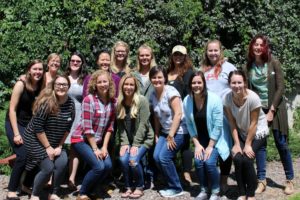Colorado State University has created a center that focuses on addressing the childhood trauma that kids served by the Larimer County Department of Human Services have experienced, and it could blossom into a national training ground for a new model of care.
The Child Trauma and Resilience Assessment Center assesses high-level childhood trauma, such as abuse, in youth between the ages of 4 and 18. The center is based in the Center for Family and Couple Therapy, which has been serving Northern Colorado for more than 25 years. Master’s and Ph.D. students in the Department of Human Development and Family Studies see clients as a part of their practicum and internships, and CTRAC is one of their rotations.

‘Expanding capacity’
CTRAC has already assessed about 90 children, and in June, the Larimer County DHS provided additional funding for the center to support expanding its capacity.
Jim Drendel, director of the Children, Youth and Family Division in DHS, said his office provided the funding in hopes that the center can become a statewide and even national resource for training professionals in this emerging “trauma-informed care” model.
“This is a great project, I’m so happy to be working with CSU,” he said. “It’s brave of them to put children first, and we appreciate the risk-taking that they are doing. It’s a fabulous group of people. We haven’t worked with academia much, so this is thrilling to me.”
‘Systems theory’
The center focuses on assessing youth using a model created by faculty at Western Michigan University led by Jim Henry, a professor of social work and director of the WMU Children’s Trauma Assessment Center.
CSU graduate students in the Marriage and Family Therapy program who work at the center are also trained in “systems theory,” which involves looking at the whole system the youth is in. In the case of the trauma center, the “system” is all of the individuals involved in the child’s life, including parents, guardians, therapists, probation officers and mentors.
CTRAC Director Stephanie Seng said trauma affects a youth’s developing brain.
“A child who has experienced trauma might have different triggers for ‘fight or flight’ than you or I do,” Seng said, explaining that trauma-informed care acknowledges that sometimes youth find themselves in difficult situations, not because they want to act out or cause trouble, but because of the way that the trauma has affected their brain and their development.
Drendel said his division hasn’t seen enough success dealing with kids in traditional ways. In the past, he said, child welfare has used a traditional behavior model that draws a line in the sand and dares the child to cross over. Of course, most cross over. This is when the cycle of bad behavior begins, he explained. According to Drendel, the new approach gets to the root of the problem by identifying and addressing the impact of children’s past trauma — instead of just treating its symptoms.

“Some of these kids have had things happen to them that are beyond our belief,” he said. “It can be a challenge because they don’t trust any of us. And these traumatized children haven’t been helped enough. Now we’re seeing some light at the end of the tunnel, and it’s not a train. Seeing something like this after all these years is pretty awesome.”
Assessment process
A team of two individuals handles each high-level assessment. There is a lead clinician, with a secondary role usually filled by a graduate student in the MFT program. Occupational therapists also play a part in the assessment. Each high-level assessment takes up to 30 hours, and is preceded by a review of the youth’s files and other information as well as interviews with caregivers and other individuals in the youth’s life.
When youths arrive at the center the morning of the assessment, they undergo several cognitive screens. In the afternoon, the team performs a psycho-social assessment to understand the youth’s perspective as well as help the youth organize his or her own experiences.
“Trauma often disrupts the ability to organize our story, and we write on a white board so that youths can clearly see their story and organize it,” said Seng, adding that sometimes kids take a photo of the white board because they have never seen their life laid out that way.
Chelsea Kline, a second-year marriage and family therapy graduate student, says CSU students are trained to see kids and their perspectives in a different way.
“Most of the time youth don’t have the opportunity to tell their story,” Kline said. “It is inspiring to see a kid leaving the room, having been heard and feeling validated. Those kids are able to have a voice that they may not have had before undergoing the assessment.”
After the assessment is done, the team debriefs and compiles a report on how trauma has affected the child’s life — and makes recommendations to help manage the impact the trauma has had.
Clinicians from the trauma center make their recommendations based on the three components of resilience: mastery, regulation and relatedness. Mastery is the way that individuals feel about themselves, regulation is how individuals manage their emotional experience, and relatedness is how individuals are able to trust in relation to others.

The recommendations that the center makes are tailored to each child. They can vary from recommending that the youth get a fitness tracker for tracking their heart rate and steps per day to suggesting that the youth enroll in painting lessons or join a local gym.
The team then meets with the child’s caregivers (and the child if he or she is old enough) to review the results of the assessment, answer questions and get feedback.
Assessment training
CSU faculty have been consulting with Henry about the trauma assessments that he and his team developed for about two years. In the upcoming months, Henry, Seng, CSU Assistant Professor CK Kemp and Amy Perricone, an interventionist and trainer at the WMU center, will be training other professionals from around Colorado, and there is even potential to become a national center to serve those in other states.
CTRAC will begin with high-level assessment training for professionals in seven Colorado counties: Jefferson, Boulder, Eagle, Larimer, Arapahoe, Douglas and Denver.
“The center has a lot of opportunity, and we are just getting started,” Seng said.
CSU’s Marriage and Family Therapy program and Center for Family and Couple Therapy are part of the College of Health and Human Sciences.